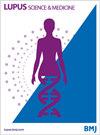Hospitalised infections and rituximab administration among children and adolescents with systemic lupus erythematosus from 2009 to 2021
IF 3.5
2区 医学
Q1 RHEUMATOLOGY
引用次数: 0
Abstract
Background Rituximab is associated with high infection rates, but studies of infections following rituximab in youth with childhood-onset SLE (cSLE) are limited. We conducted a retrospective longitudinal cohort study to assess the incidence of hospitalised infections following rituximab among children with cSLE and to assess changes in hospital-based rituximab administration over time. Methods Youth ages 2–21 years with an International Classification of Diseases (ICD) code for SLE who received rituximab during admission to a Pediatric Health Information System hospital from 2009 to 2021 were included. Incidence rates for infections requiring hospitalisation over the 12 months following first rituximab administration were calculated. Rituximab use by year of hospital discharge was tabulated. Results We identified 1567 children with cSLE who received rituximab. 219 children were admitted with an infection within 1 year after first rituximab administration, for an incidence rate of 140 cases per 1000 patient-years. Seven children (0.44%) died during a hospitalisation with an infection in the year following rituximab administration. The most common hospitalised infections were bacterial pneumonia, sepsis and cellulitis. 12 children were hospitalised with COVID-19, none of whom died. Hospitalisations with rituximab administered decreased from 2019 to 2021. Conclusions In this cohort of patients with cSLE who received inpatient treatment with rituximab, we observed a 14% rate of hospitalisation with infection in the year following rituximab administration among youth with cSLE. Rituximab use declined during the COVID-19 pandemic. No fatalities with COVID-19 were observed. Given the lack of outpatient data, including doses of concomitant medications and disease activity measures, further research is needed to identify risk factors for infection following rituximab among children with cSLE. Data are available upon reasonable request. Deidentified data may be provided upon request pending approval of the Seattle Children’s Hospital IRB and the Children’s Hospital Association.2009年至2021年系统性红斑狼疮儿童和青少年的住院感染和利妥昔单抗用药情况
背景 利妥昔单抗与高感染率有关,但有关儿童期系统性红斑狼疮(cSLE)患者使用利妥昔单抗后感染的研究却很有限。我们开展了一项回顾性纵向队列研究,以评估儿童系统性红斑狼疮患者使用利妥昔单抗后住院感染的发生率,并评估医院使用利妥昔单抗的随时间推移而发生的变化。方法 纳入 2009 年至 2021 年期间在儿科健康信息系统医院住院期间接受利妥昔单抗治疗的 2-21 岁青少年,他们的国际疾病分类(ICD)代码均为系统性红斑狼疮。计算了首次使用利妥昔单抗后 12 个月内需要住院治疗的感染发生率。按出院年份统计利妥昔单抗的使用情况。结果 我们确定了 1567 名接受利妥昔单抗治疗的 cSLE 患儿。219名患儿在首次使用利妥昔单抗后一年内因感染入院,感染率为每1000患者年140例。在使用利妥昔单抗后的一年内,有7名儿童(0.44%)在感染住院期间死亡。最常见的住院感染是细菌性肺炎、败血症和蜂窝组织炎。有 12 名儿童因 COVID-19 感染住院,但无一人死亡。从2019年到2021年,使用利妥昔单抗的住院病例有所减少。结论 在这个接受利妥昔单抗住院治疗的 cSLE 患者队列中,我们观察到在使用利妥昔单抗后的一年中,cSLE 青少年感染住院率为 14%。在 COVID-19 大流行期间,利妥昔单抗的使用率有所下降。COVID-19 没有造成死亡。由于缺乏门诊数据(包括伴随药物剂量和疾病活动指标),因此需要进一步研究以确定 cSLE 儿童使用利妥昔单抗后的感染风险因素。如有合理要求,可提供数据。在获得西雅图儿童医院 IRB 和儿童医院协会的批准后,可应要求提供去身份化数据。
本文章由计算机程序翻译,如有差异,请以英文原文为准。
求助全文
约1分钟内获得全文
求助全文
来源期刊

Lupus Science & Medicine
RHEUMATOLOGY-
CiteScore
5.30
自引率
7.70%
发文量
88
审稿时长
15 weeks
期刊介绍:
Lupus Science & Medicine is a global, peer reviewed, open access online journal that provides a central point for publication of basic, clinical, translational, and epidemiological studies of all aspects of lupus and related diseases. It is the first lupus-specific open access journal in the world and was developed in response to the need for a barrier-free forum for publication of groundbreaking studies in lupus. The journal publishes research on lupus from fields including, but not limited to: rheumatology, dermatology, nephrology, immunology, pediatrics, cardiology, hepatology, pulmonology, obstetrics and gynecology, and psychiatry.
 求助内容:
求助内容: 应助结果提醒方式:
应助结果提醒方式:


